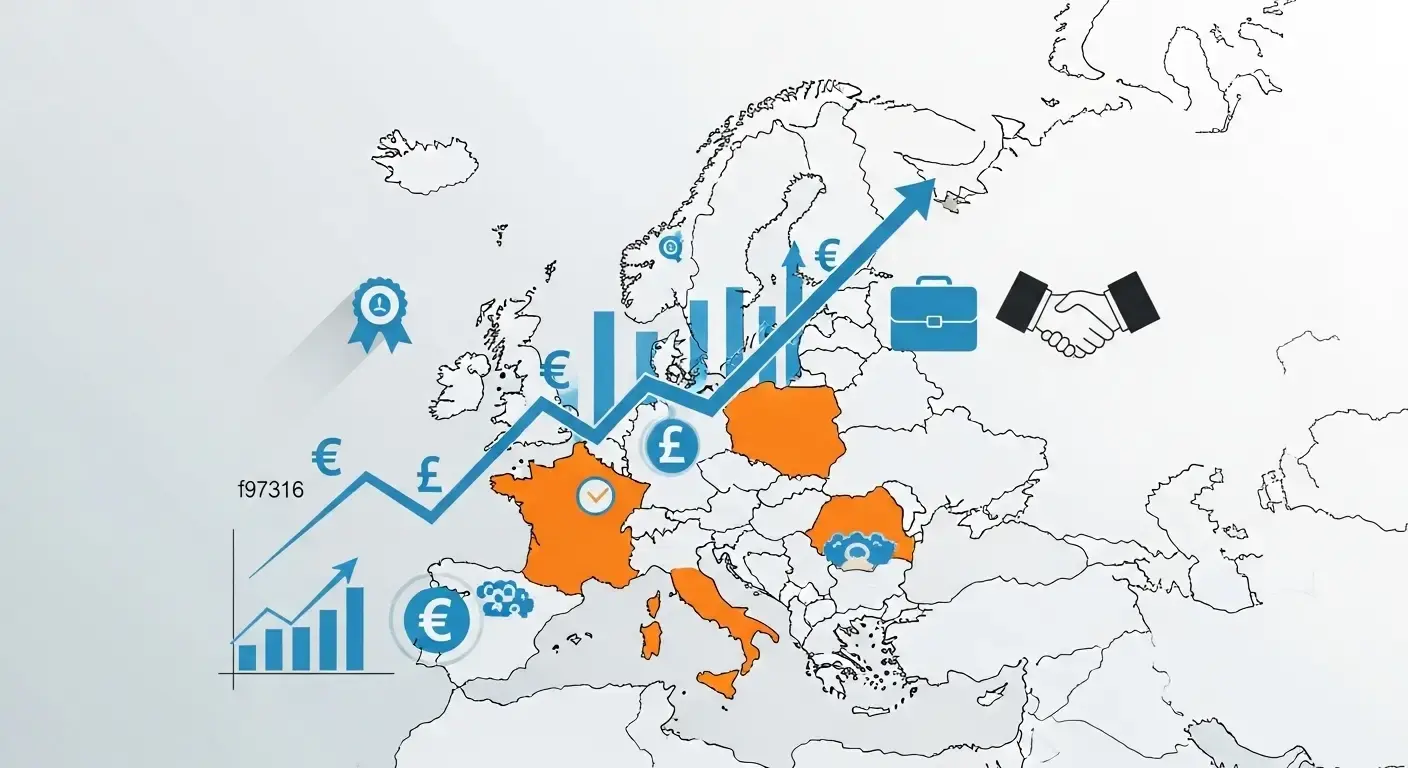The dream scenario: Your business is crushing it at home, revenue is growing, and you're ready to conquer Europe. The reality check: Most companies burn through €50,000-€200,000 in their first European expansion attempt—and still fail.
I've seen it happen dozens of times. Ambitious CEOs dive headfirst into European markets with expensive consultants, fancy offices, and elaborate launch strategies. Six months later? They're retreating home with empty pockets and bruised egos.
But here's what I've learned after helping 200+ companies successfully enter European markets: The secret isn't about having a massive budget. It's about strategic planning and knowing exactly where to focus your limited resources.
The €10,000 vs €100,000 Approach
Let me tell you about two clients who launched in Germany within the same month:
Company A (SaaS startup): Spent €120,000 on a "comprehensive market entry strategy." Hired a local PR agency, rented expensive office space in Munich, and launched with a translated website. Result? €8,000 in revenue after 12 months.
Company B (E-commerce brand): Invested €12,000 in targeted market research, cultural adaptation, and a lean digital strategy. Result? €180,000 in revenue after 12 months and profitable by month 8.
The difference? Company B understood that successful European expansion isn't about spending big—it's about spending smart.
The Smart Money Framework: 5 Steps to Budget-Friendly European Entry
Step 1: Pick Your Beachhead Market (€1,000-€2,000)
Don't try to conquer all of Europe at once. That's a recipe for disaster and budget drain.
The Smart Approach:
- Choose ONE country to start with
- Focus on markets where your product already has demand signals
- Look for English-speaking comfort zones (Netherlands, Nordics, Germany's business sector)
Budget Breakdown:
- Market research tools (SEMrush, Ahrefs): €500/month
- Local market surveys: €800-€1,200
- Competitor analysis: €300-€500
Pro Tip: Germany might seem obvious, but the Netherlands often offers easier entry with lower costs and higher English proficiency in business settings.
Step 2: Validate Before You Scale (€2,000-€3,000)
Before spending big on marketing or inventory, prove there's real demand.
Lean Validation Tactics:
- Landing page testing: Create localized landing pages for €200-€500
- Google Ads testing: Run small €50/day campaigns to test messaging
- LinkedIn outreach: Direct engagement with prospects (€0 cost, just time)
- Local partnerships: Find distributors or affiliates instead of building from scratch
Real Example: A UK fintech tested their German market with a €1,000 Google Ads campaign and a localized landing page. They got 300 qualified leads before investing anything else. That's smart money.
Step 3: Cultural Adaptation, Not Translation (€1,500-€3,000)
Here's where most companies waste money: They hire expensive translation agencies instead of focusing on cultural adaptation.
The Difference:
- Translation: "Sign up for our free trial" → "Melden Sie sich für unsere kostenlose Testversion an"
- Cultural Adaptation: Understanding that Germans prefer detailed information and trust signals over flashy CTAs
Budget-Smart Cultural Research:
- Local customer interviews: €800-€1,200 (hire local freelancers)
- Cultural consultant: €1,000-€2,000 (one-time deep dive)
- Message testing: €500-€800 (A/B testing with local audiences)
Warning: Avoid the €10,000+ "cultural strategy consultants." A smart local freelancer and your own customer research will give you better insights for 80% less money.
Step 4: Digital-First Market Entry (€3,000-€5,000)
Forget expensive physical presence. Start digital, prove demand, then expand.
Essential Digital Infrastructure:
- Localized website/landing pages: €1,500-€2,500
- Local payment methods: €500-€1,000 setup
- Customer support setup: €800-€1,200 (local freelancer or VA)
- Legal/compliance basics: €1,000-€2,000 (essential but not fancy)
Smart Hack: Instead of building everything from scratch, use existing European platforms. Sell through Amazon.de, partner with local marketplaces, or use Shopify's European infrastructure.
Step 5: Lean Marketing That Actually Works (€2,000-€4,000)
Skip the expensive PR agencies and fancy launch events. Focus on channels that deliver ROI from day one.
High-ROI Marketing Channels:
- LinkedIn outreach: €0-€500 (tools like Sales Navigator)
- Google Ads: €1,000-€2,000/month (start small, scale what works)
- Content marketing: €800-€1,500 (local freelance writers)
- Partnership marketing: €500-€1,000 (affiliate/referral setup)
Avoid These Budget Killers:
- ❌ Trade shows (€5,000-€20,000 with minimal ROI for new entrants)
- ❌ PR agencies (€3,000-€8,000/month with unclear results)
- ❌ Expensive office spaces (€2,000-€5,000/month when remote works fine)
Real Case Study: How Sarah Turned €8,000 Into €2.1M
Sarah runs a B2B SaaS company that helps restaurants optimize their supply chains. She wanted to enter the German market but had a tight budget of €8,000.
Her Smart Money Strategy:
Month 1-2: Research & Validation (€2,200)
- Hired a German freelancer to conduct customer interviews: €800
- Ran targeted LinkedIn ads to German restaurant owners: €600
- Set up localized landing pages: €400
- Market research tools: €400
Key Insight: German restaurants prioritized cost savings and compliance over flashy features—different from her UK messaging.
Month 3-4: Minimum Viable Localization (€3,100)
- Adapted messaging for German market: €500
- Basic German customer support setup: €900
- Legal compliance for German B2B sales: €1,200
- Payment integration for German businesses: €500
Month 5-6: Digital Marketing (€2,700)
- Google Ads focused on "Lieferkette optimieren": €1,500
- LinkedIn outreach to German restaurant associations: €400
- Content marketing (German blog posts): €800
Results After 6 Months:
- Investment: €8,000
- Revenue: €45,000
- Customers: 12 German restaurants
- Lessons learned: Priceless
12 Months Later: Sarah had generated €180,000 in German revenue and expanded to Austria and Switzerland using the same playbook.
The Hidden Costs Nobody Talks About
Even with a lean approach, watch out for these budget surprises:
Legal & Compliance (€1,000-€3,000)
- GDPR compliance setup
- Local tax registration
- Terms & conditions adaptation
Currency & Payment (€500-€1,500)
- Multi-currency setup
- Local payment method integrations
- Foreign exchange fees
Customer Support (€800-€2,000)
- Local language support
- European timezone coverage
- Cultural communication training
Pro Tip: Build these costs into your budget from day one. They're not optional, but they don't have to break the bank either.
Your 90-Day European Entry Action Plan
Days 1-30: Research & Validate
- [ ] Choose your beachhead market
- [ ] Conduct 10-15 customer interviews
- [ ] Test messaging with small ad campaigns
- [ ] Analyze top 5 local competitors
Days 31-60: Build Minimum Viable Presence
- [ ] Create localized landing pages
- [ ] Set up basic customer support
- [ ] Establish legal/compliance basics
- [ ] Secure local payment methods
Days 61-90: Launch & Optimize
- [ ] Start lean marketing campaigns
- [ ] Collect customer feedback religiously
- [ ] Optimize based on real data
- [ ] Plan next market expansion
The Bottom Line: Smart Beats Big
You don't need a €100,000 budget to successfully enter European markets. What you need is:
✅ Strategic focus (one market at a time) ✅ Customer obsession (understand before you sell) ✅ Lean execution (test, learn, iterate) ✅ Smart resource allocation (invest where it matters most)
The companies that succeed in Europe aren't the ones with the biggest budgets—they're the ones with the smartest strategies.
Ready to Enter European Markets Without Breaking the Bank?
I've helped 200+ companies successfully expand into European markets using these exact strategies. If you're ready to turn your European expansion dreams into reality—without risking your company's future on a massive budget—let's talk.
Book a free 30-minute strategy call and I'll help you create a custom European entry plan that fits your budget and maximizes your chances of success.
📞 Book Your Free Strategy Call →
Or email me directly: hello@komzz.com
About the Author: I'm Joe, an international expansion expert who specializes in helping businesses break through language barriers and scale globally. I've personally guided over 200 companies through successful European market entries, with an average ROI of 340% within the first year.
Categories: International Strategy, European Markets, Market Entry, Budget Planning, B2B Expansion
Tags: european expansion, market entry strategy, international business, budget planning, germany expansion, netherlands market, startup international, saas expansion europe

À propos de Komzz
Expert en expansion internationale, spécialisé dans l'aide aux entreprises pour surmonter les barrières linguistiques et se développer à l'échelle mondiale. J'ai personnellement accompagné plus de 200 entreprises dans des entrées réussies sur les marchés internationaux.

